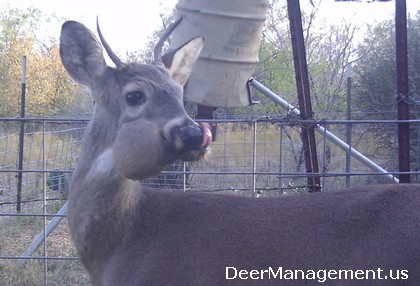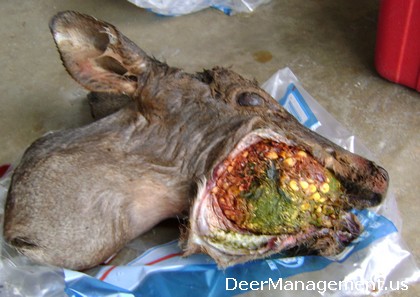A deer with a swollen mouth, jaw or cheeks can be the result of one of several things gone wrong. Often times hunters will notice these animals in game camera photos or on the hoof while deer hunting. It can be troublesome to landowners engaged in a deer management program, especially if it’s found in one of the better bucks on their ranch. The causes of swollen jaws, cheeks and deer with otherwise lumpy jaws typically results from arterial worms, cuts within the animal’s mouth that leads to food impaction, or even bacterial infection.
The photos below are of a buck that had a food impaction. The deer was located somewhere in Central Texas and I received the following information via email from a hunter. It was fortunate that the ailment could be diagnosed because after it was observed in the field the deer was subsequently shot.
“Back in late October I received a photo of a buck that looked to have food compaction/ lumpy jaw. Then again this week I received another photo of the same buck, but from a different hunter on a different ranch. The buck was killed by the second hunter and after discussion with him on the phone he cut into the mass and confirmed that it was food compaction. See photos attached.”

Bottle Jaw in Whitetail Deer
Bottle jaw in whitetail deer is a swelling beneath the jaw and is most often caused by arterial worms or liver flukes in the deer. It is distinguishable from other swellings of the jaw by being centrally located, rather soft in texture and can be moved around. Quite often, worming will cure this condition if the deer is pen-raised. Deer in the wild must live with the condition, but it may go away.
Lumpy Jaw in Whitetail Deer
Lumpy jaw also appears as a swollen jaw or cheek. It is the result of an infection of the jawbone. These lumps are immovable hard swellings of the bones, usually at the level of the central molar teeth. The swellings develop slowly and may take months to reach the size of a golf ball. They consist of honeycombed masses of bone filled with yellow pus that comprise the lumpy jaw. The swellings may become very large and discharge small amounts of sticky pus containing gritty yellow granules. The cause of lumpy jaw is a bacterium called “Actinomyces bovis“, however other organisms may invade the lesion within the deer’s mouth.
Food Impaction in Whitetail Deer Cheek
Many times hunters will encounter a deer that has a plum or orange-sized lump on it’s jaw. The lump will typically be located towards the back of the lower jaw. This lump is the result of a deer getting a cut inside it’s mouth while eating something, often times something that is not ideal for it to have inside its mouth. Then food starts to accumulate in the cut. Over time this continues to occur, filling the deer’s cheek with food items. The buck in the picture above, which is also below, had food impaction.

Can you feed an infected deer pellets that have antibiotics in the pellets?
Can anything be done for a deer with food impaction?
Diana, there really is nothing that can be done. Deer with food a food impaction will, unfortunately, have to tough it out.
Our little deer will have a lump, then it goes away and appears somewhere else on his jaws. He eats all the time and doesn’t appear to be in pain. I sure hope not.
Does this hurt the meat are u able to still eat the meat?
David, the meat is fine to eat. No problem there.
Should the deer be eliminated from the herd?
Pat, if looking to reduce the deer herd then I would target this deer over others.
will the deer die?
Rachel, the deer will die, but not necessarily from the lumpy jaw. It could however if the area gets highly infected.
We’ve been watching a fawn for a couple of months now. She seems to nurse well and is growing. We’ve noticed that she is browsing consistently. A couple of weeks ago we noticed a slight swelling on her right jaw. It has continued to grow. Nothing in her behavior would indicate pain. The deer on our place are wild, not pets. But, we’ve grown fond of watching her. Any ideas of what her problem might be? And is there anything we can do ?
Paul, it could be lumpy jaw… a condition created by arterial worms in deer.
There’s a young white tail that comes through my yard in the hill country and I noticed the underside of her jaw is swollen. Is this an impaction? Anything I can do to help?
Lisa, it’s likely an infection of some sort, but more than likely cause by an impaction. Since impactions are the result of arterial worms, and people are not allowed to provide medications to free-ranging deer, there is nothing you can do.
Alot of great information.
Scott, I’m glad you found the information useful. Thanks for taking the time to comment!
There’s a wild fawn in our gated community with swelling under her jaw. The tongue hangs out to the side. When I first noticed her a few days ago, she was drooling a lot. Our community ity is like a deer sanctuary and many of us feed and provide water to them. They share water and pellets etc are usually left on flat rocks. rather than on the dirt. Could she spread something to the others? No access is visible and she’s eating. Thanks.
I recently provided some pictures to our game commission of a doe the obviously has a food impaction issue. What bothered me is the dramatic loss of hair particularly on her neck and her mobility is greatly impaired. Are these normal symptoms of a food impaction?
Albert, that sounds like a another issue, which is not caused by a food impaction. However, if the deer is stressed or has immune issues stemming from a necrotic food impaction, then it may lead to secondary issues such as a mite infestation (mange).
WHAT FOOD IS BEST TO FEED THEE DEER WITH SWOLLEN CHEECKS, WHAT IS EASIER FORTHEM TO EAT.